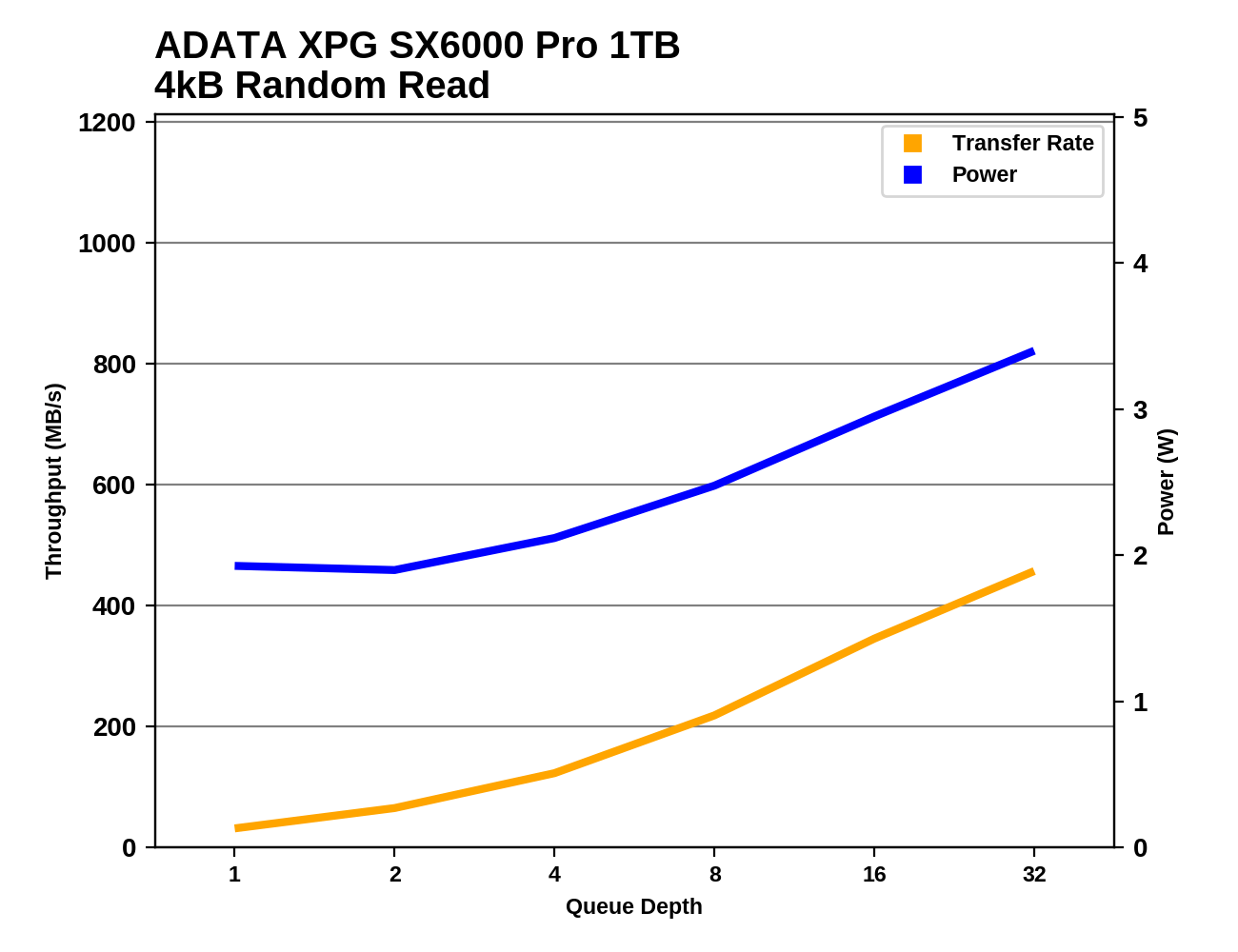The ADATA XPG SX6000 Pro 1TB SSD Review: Realtek's Entry-level NVMe Solution
by Billy Tallis on December 18, 2019 12:30 PM ESTRandom Read Performance
Our first test of random read performance uses very short bursts of operations issued one at a time with no queuing. The drives are given enough idle time between bursts to yield an overall duty cycle of 20%, so thermal throttling is impossible. Each burst consists of a total of 32MB of 4kB random reads, from a 16GB span of the disk. The total data read is 1GB.

The burst random read performance from the ADATA XPG SX6000 Pro is rather disappointing considering what drives with Silicon Motion controllers get out of the same NAND, but at least it's still a bit faster than the Crucial MX500 SATA drive that also uses Micron 64L TLC.
Our sustained random read performance is similar to the random read test from our 2015 test suite: queue depths from 1 to 32 are tested, and the average performance and power efficiency across QD1, QD2 and QD4 are reported as the primary scores. Each queue depth is tested for one minute or 32GB of data transferred, whichever is shorter. After each queue depth is tested, the drive is given up to one minute to cool off so that the higher queue depths are unlikely to be affected by accumulated heat build-up. The individual read operations are again 4kB, and cover a 64GB span of the drive.

The SX6000 Pro ranks about the same on the longer random read test, but this level of performance is more expected here given that it's a DRAMless SSD. However, the Mushkin Helix-L is in the same boat and still manages to be 28% faster.
 |
|||||||||
| Power Efficiency in MB/s/W | Average Power in W | ||||||||
Realtek's SSD controllers are still in last place for power efficiency, but the efficiency score for the SX6000 Pro is only a bit worse than for the Samsung 970 EVO Plus. The power draw of just under 2W is in the normal range for NVMe SSDs in general, but the other low-end drives draw closer to 1W.
 |
|||||||||
The random read performance of the SX6000 Pro starts out slow at QD1 but it scales up reasonably well for a 4-channel controller. Unfortunately, power consumption also scales up, so even at higher queue depths it is still relatively inefficient.
With a high enough queue depth, the random read performance of the SX6000 Pro does climb out of SATA territory, but not by much. It definitely draws more power than most drives across the entire range of tested queue depths, but isn't quite record-setting.
Random Write Performance
Our test of random write burst performance is structured similarly to the random read burst test, but each burst is only 4MB and the total test length is 128MB. The 4kB random write operations are distributed over a 16GB span of the drive, and the operations are issued one at a time with no queuing.

The burst random write performance of the SX6000 Pro is way above what the SATA drives manage, but is on the low side by NVMe standards—even when considering just the low-end NVMe drives.
As with the sustained random read test, our sustained 4kB random write test runs for up to one minute or 32GB per queue depth, covering a 64GB span of the drive and giving the drive up to 1 minute of idle time between queue depths to allow for write caches to be flushed and for the drive to cool down.

On the longer random write test, the SX6000 Pro falls far behind the high-end NVMe drives and is a bit slower than the Crucial MX500 SATA SSD. The SX6000 Pro is the fastest of the DRAMless drives in this bunch, but the Intel 660p's strategy of using QLC NAND with DRAM makes it by far the fastest low-end NVMe drive on this test.
 |
|||||||||
| Power Efficiency in MB/s/W | Average Power in W | ||||||||
The SX6000 Pro is the fastest DRAMless drive on this test, but it's also by far the most power-hungry, so its efficiency score is significantly worse than that of the Mushkin Helix-L.
 |
|||||||||
Performance and power consumption from the SX6000 Pro are unsteady throughout the random write test, but the overall trend is flat. That plus the fact that lower performance corresponds to higher power consumption shows that the drive is bottlenecked by background work, and it needs more idle time than this test provides.
Since the SX6000 Pro's SLC cache is far less effective for random writes than sequential, and it is slow about completing background maintenance, the drive is stuck firmly in SATA performance territory with power efficiency that is mediocre at best.












36 Comments
View All Comments
tlmiller76 - Saturday, December 21, 2019 - link
Can't say I've ever heard that, but it's definitely true.zepi - Thursday, December 19, 2019 - link
If your laptop has about 40Wh battery and its battery lasts 8 hours with an optimal drive, with this drive it would last about 15 minutes less. Hardly end of the world and most people wouldn't notice the difference.LMonty - Thursday, December 19, 2019 - link
It does have a 40Wh battery but lasts 6 hrs for my use case. It currently has a 275GB Crucial MX300 SSD.TrevorH - Thursday, December 19, 2019 - link
Two words that aren't usually seen together. Pro. Realtek.urbanman2004 - Friday, December 20, 2019 - link
I think I'll be better off using my SATA drives. No thanksScipio Africanus - Friday, December 20, 2019 - link
Having a quick view on amazon, its $120 here in ol US of A for the 1tb version. The Sabrent 1tb is also $120 and is one of a bunch of reference Phison E12 / Toshiba TLC designs. This is considered a top tier NVME SSD that can trade blows with the latest Samsung Evo.Nope.. that's a huge NO